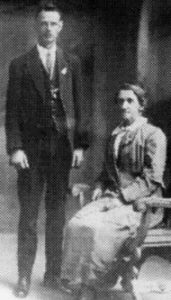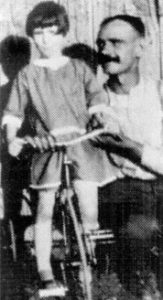Edward Henry RUNN
DCM (No 956) 1890 – 1941
Harry Runn was the only son of Henry and Maria (nee Stretton) Runn. His father was a sailor from Finland who in the late 1880’s found himself as part of a snagging team working on the Murrumbidgee River at Hay, NSW. Here he met and fell in love with Maria Jane  Stretton, eldest daughter of Edward Price Stretton and Maria Harriden.Henry and Maria were married in Hay in 1890 and were destined to have two children. Their first, Henry Edward Runn, was born on 24th November 1890 at Hay. He was followed two years later by a daughter, Christina Lillian Runn, also born at Hay.The wide, open Riverina plains around Hay were the backblock of Henry’s childhood and he grew into a strong hardy bushman who quickly attained work as a station-hand. He was handy with a rifle and an expert horseman. 1914 saw the outbreak of the Great War and in August of that same year the first Australian troops sought enlistment in the Australian Infantry Force. Five months later Harry Runn made his way to Oaklands, South Australia where he enlisted on 21st January 1915 and was appointed to the 5th Reinforcements 9th Light Horse. He was 24 years old at the time and an impressive 6’1″ in height. On 1st June, a little more than four months later, he sailed from Australian shores aboard the HMAT Botanist. After a 3 month sojourn in Egypt, during which time he was promoted to Lance Corporal, Harry sailed from Alexandria on 11th November as a private; he was bound for Gallipoli. Stretton, eldest daughter of Edward Price Stretton and Maria Harriden.Henry and Maria were married in Hay in 1890 and were destined to have two children. Their first, Henry Edward Runn, was born on 24th November 1890 at Hay. He was followed two years later by a daughter, Christina Lillian Runn, also born at Hay.The wide, open Riverina plains around Hay were the backblock of Henry’s childhood and he grew into a strong hardy bushman who quickly attained work as a station-hand. He was handy with a rifle and an expert horseman. 1914 saw the outbreak of the Great War and in August of that same year the first Australian troops sought enlistment in the Australian Infantry Force. Five months later Harry Runn made his way to Oaklands, South Australia where he enlisted on 21st January 1915 and was appointed to the 5th Reinforcements 9th Light Horse. He was 24 years old at the time and an impressive 6’1″ in height. On 1st June, a little more than four months later, he sailed from Australian shores aboard the HMAT Botanist. After a 3 month sojourn in Egypt, during which time he was promoted to Lance Corporal, Harry sailed from Alexandria on 11th November as a private; he was bound for Gallipoli.
According to Major Darley’s Regimental history “. . . with the Ninth Light Horse in the Great War, 25 reinforcements arrived from Egypt on 17th Sept. Harry would most likely have been amongst their number.” The 25 reinforcements joined the regiment at Rhododendron Spur and underwent an immediate baptism of artillery fire that lasted until the end of the month, when General Birdwood inspected the position. October was spent building winter shelters. On 10 November the regiment was relieved by the Auckland Mounted Rifles and moved to a new position at Canterbury Slope held by the 10th Light Horse. By the end of November the Peninsula was covered in snow. Around the 13th December the order was given to evacuate all sick and injured men of the regiment to Lemnos. Harry appears to have been one of these as his service record has him at the 3rd AGH in Mudros on 13th December. On 23rd Harry boarded the HMT Caledonia and the following morning sailed for Egypt, arriving at Alexandria on 27th December. On 27th February 1916 Harry and an advance party under Lieutenant T. H. Darley entrained for Serapeum to lay out a site for the 3rd Light Horse Brigade near the Suez Canal, where they remained until 27th July. On 27th July the Regiment marched northward to Bally Bunion, a few days later a new Brigade Scout Troop was formed. Lieutenant Tom Rickeby (9th L.H.) was placed in command. The troop would consist of two men from each of the 8th, 9th, and 10th Light Horse Regiments. The troop’s first patrol was on 1st August. It was probably on Lieutenant Rickeby’s recommendation that Harry was selected for the Scout Troop. On 4th August the Regiment marched out for Romani. Near Hamissah the entire Regiment became heavily engaged with at least 1000 Turks. By the end of the battle 308 of the enemy surrendered with the rest retiring in good order. Foremost in the collection of prisoners were the Brigade Scouts. The Scouts were often at the forefront of operations. Some of their tasks involved acting as guides for the Brigade, outriders, escorts for the Brigade General, and dispatch riders. They would be sent out to locate enemy positions and often draw the enemy fire. They were the first into Bethlehem, Es Salt, and Damascus, after clearing a track through the Barada Gorge. Harry’s service record states that while at Gallipoli he was promoted to Lance Corporal. However on reaching Egypt he reverted back to private. On 22nd December the Turkish held position of Magdhaba was attacked. Harry and the Scouts accompanied D Troop of the 10th Light Horse in an encircling movement behind the enemy positions. After a heroic bayonet charge the 1400 defenders surrendered. After the battle, on Christmas Day 1916, Harry was promoted to Lance Corporal again. The 9th Regiment was held at Hod Masaid. On 10th March 1917 the Scouts along with the 8th and 9th Light Horse went on a reconnaissance to Gaza. General Royston and the Scouts were the first to view Gaza. On 23rd March the 9th Light Horse made a reconnaissance in force of Gaza, led by the Scouts. On 26th March the Scout Troop led the Division forward to attack Gaza. The battle lasted all day when the Turks were reinforced, and the scouts were busy passing orders for the troops to retire during the night. The first Battle of Gaza cost 12,000 casualties. On 19th April the second Battle of Gaza commenced during which the 9th Light Horse suffered 77 casualties, including 16 dead. This second failure to take Gaza cost 15,000 casualties altogether. The following day harry was promoted to temporary corporal. On 6th May, 1917 the 3rd Light Horse Brigade moved to Tel el Fara, led by Harry and the other Scouts. On 1st August the Scout Troop made a raid on a section of Khan Yunus in search of German spies. On 3rd August harry was promoted to corporal. On 12th September Harry was admitted to the 14th A.G.H. with Dibility and rested for two weeks. His service record states ‘3rd LHR taken on strength X Hosp. . . . Moascar 1st October 1917’ On 31st October the Charge of Beersheba took place. I don’t know whether Harry was present at this famous action but might have been with 3rd LHR. On 9th January 1918 He returned to the 9th LHR. On 22nd April 1918 the Scout Troop rode into Jerusalem. Two days later they rode out for Jericho. On 1st May the 3rd LH Brigade arrived at Es Salt, held by the Turks. At 5 p.m. we attacked and captured the Turkish positions. The Scout stayed with Brigade Headquarters during the battle. On 14th June 1918 Harry was promoted to temporary sergeant. On 14th July the 9th LH marched into the Jordan Valley at Imam Aly. On 16th July the 3rd LH Brigade was ordered to relieve the 1st LH Brigade at Musselabeh. The following is from “With the Ninth Light Horse in the Great War” . . . Major Darley. I am copying it as it relates directly to Harry’s actions that had him awarded the DCM. “On the 8th a successful reconnaissance was carried out by a special patrol under Lieut. J.M. McDonald. The patrol had to report on the nature of the enemy defenses between El Baghalat and a point on the west bank of the Jordan, about three miles north of Maskerrah. This task was carried out in a most creditable manner, Lieut. McDonald and the members of his patrol being congratulated by the Brigadier on their fine work.” On 31st August Harry was admitted to hospital (I think the 14th Australian General Hospital). The regimental history states that a couple of days after this an influenza epidemic broke out, perhaps Harry was laid up because of this. During his stay in hospital he reverted to corporal.
On 6th November the regiment marched out for Tripoli, arriving a few days later. On the evening of 11th November 1918 news was received on Germany’s surrender and the end of the war. On 19th November 1918 Harry was again promoted to Troop Sergeant. On 1st January 1919 the 8th and 9th LH boarded HMT Ellinga and sailed to Port Said then travelled by train to Kantara, but were later diverted to Moascar when a rising of Egyptians occurred. On 27th April 1919 Harry was admitted to the 14th AGH at Abbassia. On 22nd May 1919 service record states M/I x Hospital Moascar. On 26th May 1919 M/O to unit – 9th LH Cairo. On the same date he was promoted to Lance Sergeant. Record states a period of 26 days in hospital. On my copy of his service record his date of embarkation to Australia and the ship he returned on are illegible; I think it was the HMT Oxfordshire as stated in the regimental history. On 10th August 1919 the Oxfordshire sailed into Largs Bay. On Harry’s return to Australia he lived and worked on Pincally Station, approximately 200 kilometres north of Broken Hill, owned by William and Mary Moyle. The following year, 1920, he married Mary Moyle who had recently become a widow. Mary already had two grown sons, William and Samuel. Three years later Harry and Mary had their only child, Lillian Jessie Runn. On 2nd April 1940 Harry enrolled in the army for a second time. He enrolled at Wayville, South Australia and although he was married he stated that he was a widower and gave his address as the “Hotel Adelaide, Pirie St, Adelaide”. His occupation was Station Overseer. On 5th April 1940 Harry reported for duty to (I think T.T. Depot). At the end of the month he was transferred to RRD. In the next two months he was promoted to Corporal then Sergeant and moved out to CDS Wayville. On 22nd August 1940 Harry was promoted to Staff Sergeant. On 1st October 1941 Harry was admitted to the Camp hospital at Wayville with Poliomyelitis. Over the next few weeks he became worse and was posted as “seriously ill”. On 22nd December 1941 Harry was transferred to Repatriation Hospital Keswick. Eight days later at 2.15 a.m. on 30th December 1941 Harry Runn DCM died. Harry is buried in the West Terrace AIF Cemetery Row 8s Grave 17c. ARTICLE SUPPLIED BY PAUL STRETTON
Roll of Honour – Henry Edward RunnService number: S213165 Rank: Staff Sergeant Unit: Recruit Reception Depot 4MD Service: Australian Army Conflict: 1939-1945 Date of death: 30 December 1941 Place of death: Australia Cause of death: Illness Source: AWM147 Roll of Honour cards, 1939-1945 War, 2nd AIF (Australian Imperial Force) and CMF (Citizen Military Force) |

